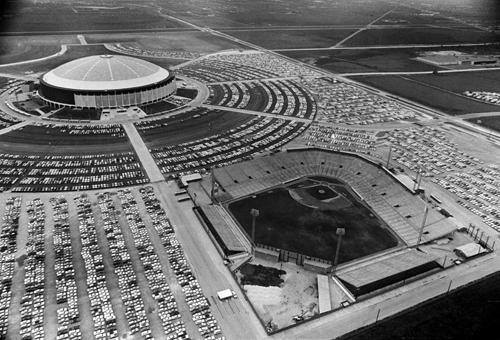This will not go down in the annals of baseball as one of the most beloved stadiums ever constructed. In fact, there are very few folks who seem to have fond memories of Colt Stadium, the three-year home of the expansion Houston Colt .45s.
Seating: 32,601 (1962), 33,010 (1964)
Original Cost: $2 million
MLB didn’t put a lot of thought and research into facilities in Houston before awarded an expansion franchise to Judge Roy Hofheinz, who had been negotiating for a Continental League franchise. As part of the agreement for the Continental League going away, both the American League and the National League expanded by two teams. So with this relatively unexpected bounty, team owners needed to find a suitable facility, and came up with Colt Stadium, a $2 million temporary stadium constructed while the Astrodome was constructed. Located in what would become the north Astrodome parking lot, Colt Stadium was arguably the worst major-league ballpark used in the last 50 years. Imagine playing outdoors in Houston in the summertime, and then imagine cramming 10,000 sweaty bodies into a temporary stadium — the perfect environment to attract tens of thousands of mosquitoes.
The design of the stadium was on the simple side: a single-tier grandstand went from foul pole to foul pole, with half of the seating flamingo-colored seats and the other half bleachers. There were additional bleachers in both left and right field, while the scoreboard was located in center field (which didn’t do a lot of good for those sitting in the outfield bleachers). Because the entire stadium was a single-deck stadium, there was no second deck to provide any shade. (No wonder that the First-Aid room was regularly visited by those suffering from heat exhaustion — almost 80 during one memorable 1962 doubleheader.) In a show of mercy, the National League suspended a rule against Sunday night games so the Colt .45s could get out of the hot Houston midday sun. The infield was rock-hard and hot, and players took salt tablets during the game. If the sun didn’t get you, the bugs did, although insect repellant was available at the concession stands. The scoreboard itself was an oddity when the ballpark opened, as it displayed hits ahead of runs in the line score.
The first game at Colt Stadium was on April 10, 1962, with the expansion Colt .45s beating the Chicago Cubs 11-2 before 25,271 fans. Despite this score, the .45s didn’t exactly pound the cover off the ball in Colt Stadium, finishing last in the National League in hitting and runs scored. Part of this was due to the team being an expansion franchise, of course, but a larger part of the issue has to do with the attributes of Colt Stadium itself. Even when the team played games in the evening, the Houston weather did not cooperate, as anyone who has spent a summer in Houston knows; the humid, sticky hot air in Houston tended to keep balls within the park. And the dimensions of Colt Stadium — a very spacious 427 feet to the power alleys and 420 to dead center field — also kept many a well-hit ball in the stadium. Two Colt .45s threw no-hitters (Don Nottebart in 1962 and Ken Johnson in 1963), but there was no doubt that both were aided by the conditions at Colt Stadium.
That’s why there were very few tears shed on that final Colt Stadium game on September 24, 1964. With the end of Colt Stadium also came the end of the Houston Colt .45s: when the team moved across the parking lot to the Astrodome for the 1965 season, they adopted a new team name — the Houston Astros — that reflected the national interest in the space program and Houston’s central role in the race for space.
Colt Stadium stood until 1970, used mostly for storage; Astros owner Judge Roy Hofheinz painted the stadium gray so that it could not be seen in aerial photos of the Astrodome. After Harris County declared that it was still indeed a structure and was therefore liable for property taxes, Hofheinz dismantled it, where it sat in the parking lot. Colt Stadium had a second life as a pro baseball stadium when it was sold to the Torreon Cotton Pickers of the Mexico League team for $100,000 and used for several years there. (Locals called it “El Mecano.”) It was moved once more to Tampico, where it was home to the Tampico Stevedores. It was almost moved a third time to Mexico City to be the home of the Tigers, but some wiser heads prevailed and the structurally weakened ballpark was torn down, with some of the seating going to a factory workers’ league near Pasteje and the rest to a public playground in Tampico, Mexico.
| Dimensions | |||||
| Year | LF | LC | C | RC | RF |
| 1962-1964 | 360 | 427 | 420 | 427 | 360 |
| Year | Attendance | Average | Rank in League | Record | Standing | |
| 1962 | 924,456 | 11,413 | 7th out of 10 | 64-96 | 8 | |
| 1963 | 719,502 | 8,883 | 10th out of 10 | 66-96 | 9 | |
| 1964 | 725,773 | 8,960 | 10th out of 10 | 66-96 | 9 |

